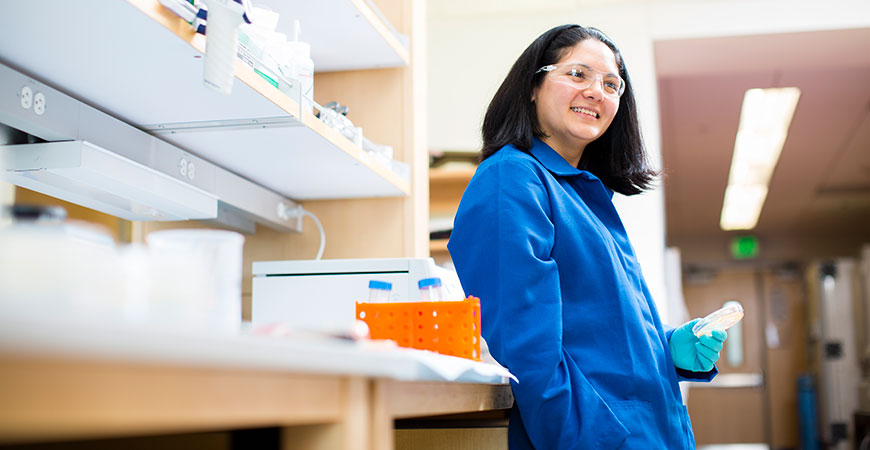
The National Institutes of Health are backing Professor Clarissa Nobile ’s mission to understand the mechanisms by which microbes form biofilms, specifically those that can be hazardous to human health.
Biofilms are communities of microorganisms encased in protective matrices and are implicated in a wide range of infections, particularly chronic and recurrent ones. Such infections can occur naturally within tissues, for example: yeast infections, urinary tract infections, wound infections, ear infections, endocarditis and lung infections associated with cystic fibrosis.
But often, biofilm infections are associated with medical devices, including catheters, pacemakers, heart valves and artificial joints.
Nobile’s work could lead to new prevention, diagnostic and therapeutic strategies to combat biofilm infections.
In 2017, Nobile, an affiliate of the Health Sciences Research Institute, received her first Maximizing Investigators' Research Award (MIRA). Known as the Outstanding Investigator Award, it was the first of its kind awarded to a UC Merced faculty member and another mark of distinction for Nobile, who became the university’s first Pew scholar in 2015.
The initial MIRA provided $1.89 million over five years. This spring, the award was competitively renewed for an additional five years and $2.5 million.
“Our research has two arms in terms of biofilms and microbial communities. There is the single-species arm and the poly-microbial arm,” Nobile said. “For the single-species arm, we study biofilms and how one species can interact with its own cells and create this complex architecture that is the biofilm.
“Usually, we don't think of microbes as doing that; we think of microbes as just doing their own thing. But in times of stress and for other reasons, they can work together and form these communities that are important because they give the microbes recalcitrance to environmental stresses and make them more resistant to antibiotics or antifungals.”
Several infections are caused by a single species, such as Candida albicans yeast infections, which Nobile’s lab has been investigating for more than a decade. One of her lab's goals is to understand how these biofilms form and are maintained, as well as how they evolve.
“We still don't have a very good way to treat certain infections because they are often recurrent and it's because we haven't gotten rid of the source of the infection – the biofilm – we've only treated the symptoms,” Nobile said. “Part of what we're doing now is looking for more effective strategies, including new therapeutics, to specifically target the source of the infection.”
Even more complications arise when an infection involves multiple microbial species. Often, when someone contracts an infection in the hospital, such as one associated with a catheter, it involves more than one species and can be significantly more challenging to treat.
“Multiple species can form biofilms together and we know very little about how that happens,” she said. “Microbes from across kingdoms or even from two different kingdoms, such as bacteria and fungi, can come together and make these complex communities and become more drug-resistant than they would be individually.”
She and her lab are working to understand how genes are regulated within the context of these single- and multiple-species biofilm structures, to identify new drug targets and determine how to prevent biofilms from forming in the first place.
Many of the microbes Nobile’s lab studies occur naturally in the human body and typically don't make a person sick, as they are kept under control by the immune system.
However, it is a delicate balance that can be disrupted by illness or treatments for other conditions. Antibiotics may eliminate a strep throat infection, but by killing off the bacteria that keep other microbes in check, the patient can now develop a yeast infection, for example.
When biofilm infections form on medical devices, such as prosthetic joints or heart valves, the only real treatment is to have them removed surgically, Nobile explained. That's why it's essential to develop prevention and treatment strategies.
“Forming biofilms is a microbe’s defense system. They want to survive. And our defense mechanism is our immune system. It's constantly battling to keep us safe. But we evolve much slower than microbes because they can reproduce so much faster,” she said. “We have discovered some ways to prevent biofilms from forming in the lab, but whether we can apply that to a person is the next step.”



